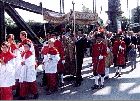
![]()
Welcome to:
St. Martin's
Day
[ Back
to Homepage ][ Bulletin
Board ]

Martinstag (St. Martin's Day) |
|
After Halloween is over, German children have another opportunity to do a little more "trick or treating" of sorts. On November 11 each year German children celebrate St Martin's Day. Carrying lanterns, and singing special lantern songs they walk around the streets in a procession after darkness falls. The procession often ends with a bonfire after which they may go from door to door singing songs. Much like trick or treating in the USA, the children are given candy, money and other goodies as a reward for their singing and the beauty of their homemade or purchased lanterns. The lanterns may be used to store the candy and treats until they return home. St. Martin's Day is one of the most popular saint's days in Germany and is celebrated mostly by youth and rural populations. Martin of Tours was born in the 4th Century and started out as a Roman soldier, later becoming a monk, and because of his exemplary way of life was later appointed Bishop of Tours (against his will). Many legends surround his life, the most famous of which tells how he cut his cloak in half to share with a beggar who was dying in the cold. St. Martin's Day is also the official start of Karneval, Fasching and Fastnacht at eleven minutes past eleven on the eleventh day of the eleventh month. It's at this time that carnival clubs and neighborhood groups start their preparations for the carnival season that culminates with the big Fasching (Mardi Gras) parades in February. St. Martin's Day also marks the end of the agrarian year and the start of the harvesting season. The symbol of St. Martin's Day is the goose. Legend has it that St. Martin was betrayed by geese gabbling whilst he was trying to hide in a stall to avoid being appointed Bishop of Tours. Actually the real reason that the first goose of the season is eaten on St. Martin's Day is that they are ready for harvesting at this time of year. Moreover the eggs and fat were used for baking and the feathers were used for pillows and featherbeds and even to create a sort of Christmas tree. Roast goose frequently appears on menus all over Germany. Its dark, delicious and tender meat cooks to a light crispiness on the outside while the rich skin means the flesh bastes itself. Cook tasty liver pate and rye breadcrumbs stuffing balls alongside and, for a special serving, add halved fresh peaches baked and glazed with sugar and redcurrants. |
|
The "Diocese of Trier" has a page they call "An Encyclopedia of St. Martin of Tours" or what is an A-Z of "St. Martin of Tours".
Feast of St Martin's Day
Tis the season in Germany to butcher the fatted goose. So
enjoy!
St. Martin's Day (Advent)
Alles fur Ganz (G)
GermanFood.org (E)
Celebrations in the USA
German Society Club Philadelphia (E)








